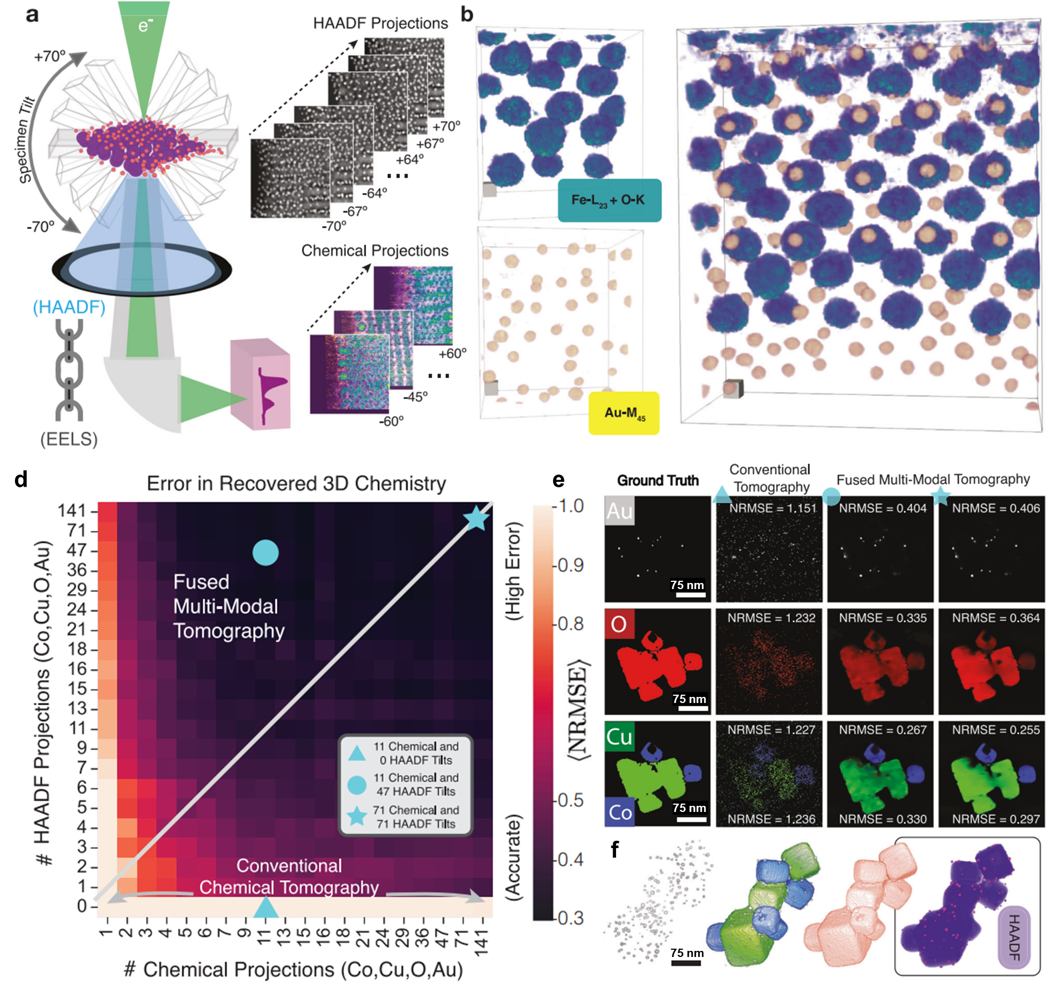How can electron tomography signals be combined to reduce beam exposure?
Jonathan Schwartz, Robert Hovden, and their colleagues at the University of Michigan, Argonne National Laboratory, Northwestern University, UC-Berkeley, Berkeley Lab, Cornell University, and Dow Chemical Co. published work using the Hummingbird Scientific tomography sample holder to perform 3D electron tomography on nanoscale samples that are highly sensitive to beam damage. The team combined elastic high angle annular dark field (HAADF) and inelastic energy dispersive X-ray spectroscopy and electron energy loss spectroscopy (EDX/EELS) signals perform high resolution chemical tomography with drastically reduced dose.

a) Schematic of the linked HAADF and EELS modalities for chemical tomography. HAADF projection images are collected at every tilt increment while core-loss EELS spectra are sparsely acquired every few tilts. b) The fused multi-modal reconstruction for the specimen’s Fe L2,3 (turquoise), O-K (turquoise), and gold M4,5 edges (yellow). c) Chemical overlay of the superlattice nanoparticles over the entire 115 nm field of view. Scale of cubes= 5 nm3. d) Normalized root mean square error map representing the recovery error as a function of the number of HAADF and chemical tilts applied during reconstruction. e) Visualization of chemical mapping quality three points corresponding to conventional chemical tomography, low and high-dose fused multi-modal electron tomography. f) 3D models used for generating synthetic chemical and ADF projections. Copyright 2024 Springer Nature Limited
Using this fused multi-modal approach to electron tomography, 3D chemical mapping was achieved in three beam sensitive materials with resolution near or below 1 nm. Simulations of sampling combination requirements for accurate chemistry recovery of synthetic CoO/CuO nanocubes were compared, with multi-modal tomography yielding a 3-5 fold improvement in recovery error over conventional chemical tomography. The high tilt angle, and rotational stability of the Hummingbird tomography holder combined with this novel technique will enable higher resolution 3D chemical imaging of beam sensitive materials, accelerating development of nanomaterial synthesis, processing, and characterization.
Reference: Jonathan Schwartz, Zichao Wendy Di, Yi Jiang, Jason Manassa, Jacob Pietryga, Yiwen Qian, Min Gee Cho, Jonathan L. Rowell, Huihuo Zheng, Richard D. Robinson, Junsi Gu, Alexey Kirilin, Steve Rozeveld, Peter Ercius, Jeffrey A. Fessler, Ting Xu, Mary Scott, & Robert Hovden, Nature Communications 15 3555 (2024) DOI: 10.1038/s41467-024-47558-0
Full paper Copyright © 2024 Springer Nature Limited
View All News

